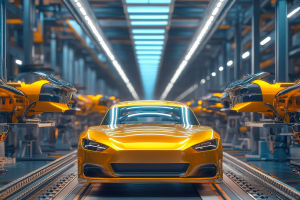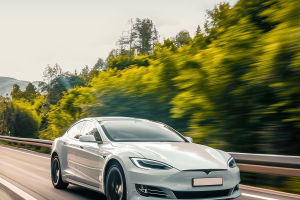Imagine a world where the daily commute is no longer a stressful experience of navigating traffic, looking for parking, or worrying about distractions.
Instead, we sit back, relax, and let our self-driving cars take us to our destinations. It might sound like a futuristic dream, but autonomous vehicles are already becoming a reality.
In fact, many companies are testing and refining their self-driving technologies—from Tesla to Waymo, and even traditional automakers like Ford and General Motors.
But what does this mean for us, both as individuals and as a society? The shift to self-driving cars is not just about convenience; it could fundamentally change the way we live, how we design our cities, and how we interact with our environment.
Redefining Traffic Patterns
One of the first areas where we can expect self-driving cars to make a major impact is traffic management. Imagine a world where vehicles can communicate with each other, ensuring smooth traffic flow with optimized routing and coordinated movement.
Self-driving cars are equipped with sensors, cameras, and AI-powered algorithms, allowing them to react faster than human drivers. This could dramatically reduce traffic jams, making commutes faster and more predictable.
In fact, experts believe that if a significant portion of cars on the road are autonomous, we could see fewer accidents and more efficient road usage. Traffic lights could become obsolete, replaced by dynamic communication between vehicles. The need for traffic congestion might become a thing of the past, as self-driving cars will be able to keep a steady, safe pace without the constant stop-and-go patterns we experience today.
Changing the Insurance Landscape
But with these changes come challenges, particularly in areas like insurance. As self-driving cars take over the roads, the traditional insurance model is bound to change. Today, insurance policies are based on human drivers' actions—speeding, poor driving habits, or accidents.
With autonomous vehicles, however, most of these risks could be reduced, as the AI driving the car is designed to make safe, calculated decisions.
Experts like Dr. John M. Sullivan, a leading expert in automotive insurance, predict that liability will shift from drivers to manufacturers. If an autonomous vehicle crashes, it's likely the responsibility will fall on the company that made the vehicle or developed the software. This shift could lead to new insurance policies tailored specifically for self-driving cars, with lower premiums for consumers as the risk of accidents decreases.
Impact on Urban Planning and Design
Perhaps one of the most exciting aspects of autonomous vehicles is their potential to transform how we design and interact with cities. With self-driving cars, we could see fewer parking lots, as cars can park themselves in more remote areas or be summoned when needed.
This would free up valuable urban space for parks, public spaces, and pedestrian zones.
In addition, streets themselves might be re-designed. With more efficient traffic patterns and fewer cars needing parking spots, roads could be narrower, smarter, and more pedestrian-friendly. Cities might even become less reliant on private car ownership, as car-sharing systems, powered by self-driving technology, could make transportation more affordable and accessible for everyone.
Social and Economic Implications
While self-driving cars could offer many benefits, they also bring new questions about their impact on jobs and the economy. Millions of people today rely on driving for their livelihood—truck drivers, taxi drivers, delivery drivers, and even chauffeurs.
As autonomous vehicles become more common, these jobs could disappear, leading to potential economic disruption. At the same time, self-driving cars could create new industries, from the development and maintenance of the vehicles to the creation of new services, like autonomous ride-sharing. Experts are already discussing universal basic income (UBI) as a possible solution to support workers who may be displaced by automation.
Ethical Considerations: Who's Responsible?
With all this exciting potential, there are also ethical questions we must address. In an accident involving an autonomous vehicle, who is liable? Should self-driving cars prioritize the safety of their passengers over pedestrians, or should they be programmed to minimize overall harm?
These ethical dilemmas will need to be solved before self-driving cars can be fully integrated into society.
Dr. Sandra O'Connor, a professor of ethics at Stanford University, argues that we need clear frameworks for how autonomous systems should make decisions, especially in life-and-death situations. She suggests that regulatory bodies will have to step in to establish ethical guidelines for autonomous technology, ensuring that they prioritize human life and adhere to moral standards.
Looking Ahead: The Road to Autonomous Living
As we move forward, we're looking at a future where autonomous vehicles will not only change the way we drive but also how we live. From transforming our cities to reshaping our insurance policies, the possibilities are vast. Self-driving cars could make our commutes safer, cities more livable, and reduce our carbon footprint.
But there's still a long road ahead.
The transition to a fully autonomous world will require collaboration between technology developers, lawmakers, and society as a whole. We'll need to ensure that these changes benefit everyone—creating a world that is safer, more efficient, and more inclusive for all.
What do you think the future holds for self-driving cars? Are you excited about the possibilities, or do you have concerns? Let us know your thoughts!
In conclusion, while the future of self-driving cars presents incredible opportunities, it also raises challenges that we will need to navigate as a society. The evolution of autonomous vehicles could fundamentally alter the way we think about transportation, our cities, and our daily lives. The road ahead may be uncertain, but it is one full of potential for innovation and transformation.


